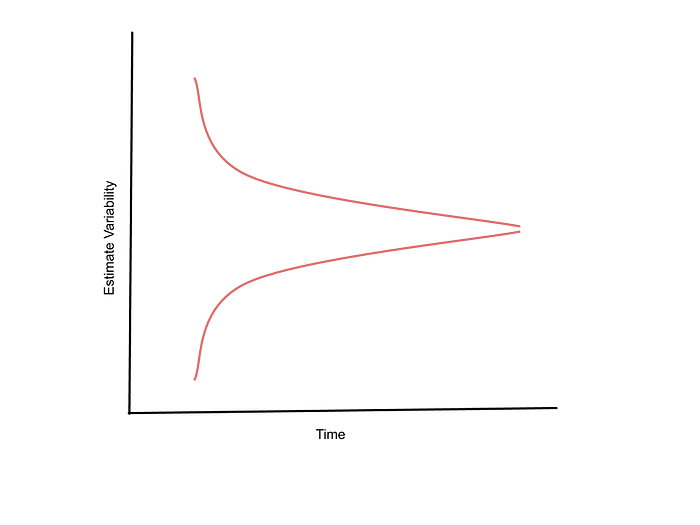The middle slump: the power of weekly project goals

There’s a thing writers call the middle slump. It’s that period in the middle of writing something when the author has lost initial momentum, feels stuck and has difficulty making forward progress.
A post in the writing subreddit frames it well: “The beginning of your story is so far behind you and yet the end is nowhere in sight”.
The idea of the middle slump is pretty universal. There are examples everywhere. From the infamous mid-life crisis to the way 2/3ds of the population feels in the afternoon.
The middle slump on projects
Projects are no stranger to the middle slump.
Even well planned projects have a tendency to go sideways in the middle. Complacency creeps in, you become more vulnerable to interruptions and your focus and resolve wane.
It’s also when stakeholders are the least likely to be paying attention. In many ways the middle of a project is the most important part because it’s where you’re most likely to get off track. It takes intention and concerted effort to fight the middle slump. So how can you do it?
Making your own ends
One of the reasons projects tend to pick up at the end is because people can see and feel that the end goal is within reach. Goals feel much more tractable and reachable when you have a line of sight to their completion.
If you can create a series of near-term goals on a project, you can create a series of reachable ends¹. Having near-term goals also helps create localized focus and really puts your current work in context. When the team starts to achieve smaller goals, they will start to feel like they are making progress. This will build momentum and help them push through the middle slump.
Weekly goals
The work week is a natural boundary for setting regular, near-term project goals. It’s already there. It has a well-defined start and end. It requires no special planning.
Using weekly goals is straight-forward. Working back from your end goal, break down and chart out a sequence goals for each week between now and the end of your project. For any given week, you’ll have 1 or more goals. 1–2 goals is what I find works best. If you have more than 3 it’s probably a sign your goals are turning into list of tasks.
A helpful way to frame thinking about weekly goals is to ask yourself “ what would I like to be true at the end of this week for this project? “.
What would I like to be true at the end of this week for this project?
A goal is not just a completed project task. Accomplishing a weekly goal should get you materially closer to your end goal². In my experience, the best weekly goals represent something logical; higher order than a task or ticket; more like a post-condition or precondition for what comes next.
When a goal is something logical, you can more effectively optimize for it, making smarter trade-offs throughout the week about how you approach the work. Some examples:
- Cutting scope from a ticket that won’t contribute to the goal
- Realizing you missed an important requirement to achieving the goal
- Deferring a task or ticket which isn’t required to meet the goal
If you’re unsure what the goals might be for weeks further out, it’s a good sign you still have some important unknowns in your project. In this case, de-risking a specific unknown (say with a spike ticket) might be a great near-term weekly goal. The goal might be to have an answer for an important question through research or to have decided on an approach to a particular problem.
Using weekly goals requires little ceremony. All you need to do is get the team clear on what the goals are for the week, each week. You can do this in a daily standup, or if you have a weekly team meeting, as a quick project update. It doesn’t require a new meeting. The start of the week is best. It helps set context for the week and ensures everyone understands what the goals are for the week and why they’re important. Team members should be able to see how their work will contribute to achieving those goals.
Also take the time during the meeting to look further ahead so the team can see what’s next. When done well this will increase team engagement, invite questions, and create high-fidelity discussion that surfaces important potential problems. The outcome you want is to get everyone aligned and bought-in to the goals.
Creating weekly goals is best done by a project leader. The project leader will already be responsible for overall project planning and delivery, so it makes sense for them to do it.
Using your weekly goals document
Once you have your goals set, it’s a good idea to weigh every task you consider working on against your weekly goals. A good goal makes it easy to decide whether a ticket is in or out. The ticket might be needed eventually, but question whether it is really needed right now, which is what matters. If you are breaking down your end goal properly, every goal you have in front of you will be helping you make progress against your later goals.
It’s important not to treat weekly goals as a “set it and forget it” exercise. If you create them and never look at them again, you are missing the point. It’s meant to be a living document. Revisit your weekly goal plan based on new information. Test your assumptions and adjust as needed.
Not a substitute for project planning
Weekly goals are not a substitute for project planning. They are a tactical tool for maintaining focus on a project that’s already planned.
I like to think of weekly goals as fitting into a broader composition of goal breakdown. The idea is to break down your goals into different levels of granularity, so that at each level you can see how the goals ladder-up to achieving the next larger goal.

For small projects weekly goals are usually enough. On larger projects you will need to use milestones, and perhaps even subdivide milestones into phases. Milestones represent significant achievements. They have more organizational visibility and may be tracked and reported on to senior management. Phases might be significant internal achievements along the way.
Projects obey the cone of uncertainty; you can’t know or plan every detail until the end. Things will change and you will learn and make discoveries along the way. The further out you look, the more your plans represent brush strokes rather than specific details.

Weekly goal breakdown works best when you are looking at work within the next month or so. At that point, you have a reasonably good grasp on what needs to be done, you just need to map it out. Within the goal breakdown model above, using weekly goals makes the most sense within the context of your current phase or milestone.
Conclusion
Entropy is the natural order of things, and that presents challenges for all but the smallest projects. Progress is made when you have line of sight to your next goal. With clear and achievable near-term goals you significantly improve your chances of achieving your ultimate goal, while gathering small wins along the way. That momentum will help push you forward when you need it the most.
Consider giving weekly goals a try on your next project. It will require very little additional effort on top of your existing process, and might just help you navigate those choppy project waters out there in the middle.
[1]: And wins!
[2]: Remember activity != process
Originally published at https://leeorengel.com on January 18, 2021.
